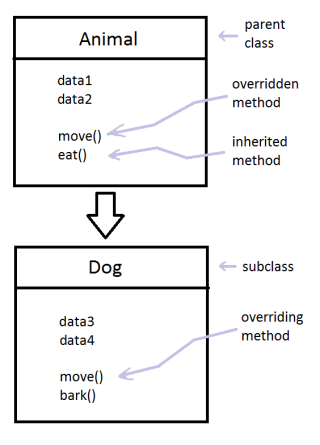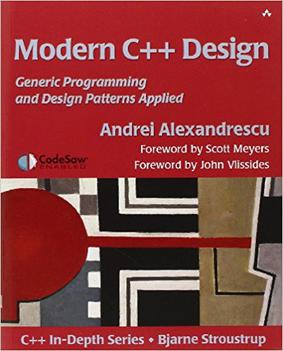Related Research Articles
In object-oriented programming, a class is an extensible program-code-template for creating objects, providing initial values for state and implementations of behavior.

Dylan is a multi-paradigm programming language that includes support for functional and object-oriented programming (OOP), and is dynamic and reflective while providing a programming model designed to support generating efficient machine code, including fine-grained control over dynamic and static behaviors. It was created in the early 1990s by a group led by Apple Computer.
Multiple inheritance is a feature of some object-oriented computer programming languages in which an object or class can inherit features from more than one parent object or parent class. It is distinct from single inheritance, where an object or class may only inherit from one particular object or class.
In object-oriented programming, the decorator pattern is a design pattern that allows behavior to be added to an individual object, dynamically, without affecting the behavior of other objects from the same class. The decorator pattern is often useful for adhering to the Single Responsibility Principle, as it allows functionality to be divided between classes with unique areas of concern as well as to the Open-Closed Principle, by allowing the functionality of a class to be extended without being modified. Decorator use can be more efficient than subclassing, because an object's behavior can be augmented without defining an entirely new object.
In software design and engineering, the observer pattern is a software design pattern in which an object, named the subject, maintains a list of its dependents, called observers, and notifies them automatically of any state changes, usually by calling one of their methods.
In computer programming, the strategy pattern is a behavioral software design pattern that enables selecting an algorithm at runtime. Instead of implementing a single algorithm directly, code receives run-time instructions as to which in a family of algorithms to use.

The Common Lisp Object System (CLOS) is the facility for object-oriented programming which is part of ANSI Common Lisp. CLOS is a powerful dynamic object system which differs radically from the OOP facilities found in more static languages such as C++ or Java. CLOS was inspired by earlier Lisp object systems such as MIT Flavors and CommonLoops, although it is more general than either. Originally proposed as an add-on, CLOS was adopted as part of the ANSI standard for Common Lisp and has been adapted into other Lisp dialects such as EuLisp or Emacs Lisp.
In computer programming, a generic function is a function defined for polymorphism.
In object-oriented programming, in languages such as C++, and Object Pascal, a virtual function or virtual method is an inheritable and overridable function or method for which dynamic dispatch is facilitated. This concept is an important part of the (runtime) polymorphism portion of object-oriented programming (OOP). In short, a virtual function defines a target function to be executed, but the target might not be known at compile time.
In computing, type introspection is the ability of a program to examine the type or properties of an object at runtime. Some programming languages possess this capability.

Method overriding, in object-oriented programming, is a language feature that allows a subclass or child class to provide a specific implementation of a method that is already provided by one of its superclasses or parent classes. In addition to providing data-driven algorithm-determined parameters across virtual network interfaces, it also allows for a specific type of polymorphism (subtyping). The implementation in the subclass overrides (replaces) the implementation in the superclass by providing a method that has same name, same parameters or signature, and same return type as the method in the parent class. The version of a method that is executed will be determined by the object that is used to invoke it. If an object of a parent class is used to invoke the method, then the version in the parent class will be executed, but if an object of the subclass is used to invoke the method, then the version in the child class will be executed. This helps in preventing problems associated with differential relay analytics which would otherwise rely on a framework in which method overriding might be obviated. Some languages allow a programmer to prevent a method from being overridden.
Flavors, an early object-oriented extension to Lisp developed by Howard Cannon at the MIT Artificial Intelligence Laboratory for the Lisp machine and its programming language Lisp Machine Lisp, was the first programming language to include mixins. Symbolics used it for its Lisp machines, and eventually developed it into New Flavors; both the original and new Flavors were message passing OO models. It was hugely influential in the development of the Common Lisp Object System (CLOS).

Modern C++ Design: Generic Programming and Design Patterns Applied is a book written by Andrei Alexandrescu, published in 2001 by Addison-Wesley. It has been regarded as "one of the most important C++ books" by Scott Meyers.
In object-oriented programming, inheritance is the mechanism of basing an object or class upon another object or class, retaining similar implementation. Also defined as deriving new classes from existing ones such as super class or base class and then forming them into a hierarchy of classes. In most class-based object-oriented languages like C++, an object created through inheritance, a "child object", acquires all the properties and behaviors of the "parent object", with the exception of: constructors, destructors, overloaded operators and friend functions of the base class. Inheritance allows programmers to create classes that are built upon existing classes, to specify a new implementation while maintaining the same behaviors, to reuse code and to independently extend original software via public classes and interfaces. The relationships of objects or classes through inheritance give rise to a directed acyclic graph.

Scala is a strong statically typed high-level general-purpose programming language that supports both object-oriented programming and functional programming. Designed to be concise, many of Scala's design decisions are aimed to address criticisms of Java.
In programming languages, an abstract type is a type in a nominative type system that cannot be instantiated directly; by contrast, a concrete typecan be instantiated directly. Instantiation of an abstract type can occur only indirectly, via a concrete subtype.
In computer programming, a trait is a concept used in programming languages which represents a set of methods that can be used to extend the functionality of a class.
An interface in the Java programming language is an abstract type that is used to declare a behavior that classes must implement. They are similar to protocols. Interfaces are declared using the interface keyword, and may only contain method signature and constant declarations. All methods of an Interface do not contain implementation as of all versions below Java 8. Starting with Java 8, default and static methods may have implementation in the interface definition. Then, in Java 9, private and private static methods were added. At present, a Java interface can have up to six different types.
The curiously recurring template pattern (CRTP) is an idiom, originally in C++, in which a class X derives from a class template instantiation using X itself as a template argument. More generally it is known as F-bound polymorphism, and it is a form of F-bounded quantification.

Composition over inheritance in object-oriented programming (OOP) is the principle that classes should favor polymorphic behavior and code reuse by their composition over inheritance from a base or parent class. Ideally all reuse can be achieved by assembling existing components, but in practice inheritance is often needed to make new ones. Therefore inheritance and object composition typically work hand-in-hand, as discussed in the book Design Patterns (1994).
References
- 1 2 "Using Mix-ins with Python | Linux Journal". www.linuxjournal.com. Retrieved 2023-05-23.
- 1 2 AOL.COM, Bapopik at (3 August 2002). "Mix-Ins (Steve's ice cream, Boston, 1975)" . Retrieved 2023-05-23.
- 1 2 "Implementing Mixins with C# Extension Methods". Zorched / One-Line Fix. Retrieved 2023-05-23.
- 1 2 "I know the answer (it's 42) : Mixins and C#". 2006-09-04. Archived from the original on 2006-09-04. Retrieved 2023-05-23.
- ↑ Boyland, John; Giuseppe Castagna (26 June 1996). "Type-Safe Compilation of Covariant Specialization: A Practical Case". In Pierre Cointe (ed.). ECOOP '96, Object-oriented Programming: 10th European Conference. Springer. pp. 16–17. ISBN 9783540614395 . Retrieved 17 January 2014.
- ↑ "Mix In". wiki.c2.com. Retrieved 2023-05-23.
- ↑ "Working with Mixins in Ruby". 8 July 2015.
- ↑ "Re-use in OO: Inheritance, Composition and Mixins".
- ↑ "Moving beyond mixins » Justin Leitgeb". Archived from the original on 2015-09-25. Retrieved 2015-09-16.
- ↑ "Mixin-based Inheritance" (PDF).
- ↑ Bill Wagner. "Create mixin types using default interface methods". docs.microsoft.com. Retrieved 2022-04-18.
- ↑ slava (2010-01-25). "Factor/Features/The language". concatenative.org. Retrieved 2012-05-15.
Factor's main language features: … Object system with Inheritance, Generic functions, Predicate dispatch and Mixins
- ↑ "Classes - MATLAB & Simulink - MathWorks India".
- ↑ Alain Frisch (2013-06-14). "Mixin objects". LexiFi. Retrieved 2022-03-29.
- ↑ "Mixin Class Composition". École polytechnique fédérale de Lausanne . Retrieved 16 May 2014.
- ↑ "XOTcl - Tutorial". media.wu-wien.ac.at. Retrieved 2023-05-23.
- ↑ "cpython: 2cb530243943 Lib/socketserver.py". hg.python.org. Retrieved 2023-05-23.
- ↑ "Mixins, Forwarding, and Delegation in JavaScript".
- ↑ "DRY JavaScript with mixins". Archived from the original on 2015-09-21. Retrieved 2015-09-16.
- ↑ "Default Methods (The Java™ Tutorials > Learning the Java Language > Interfaces and Inheritance)".
- ↑ Mixins, generics and extension methods in C#
- ↑ "Extension methods". flutterbyexample.com. Retrieved 2023-05-23.
- ↑ "Create mixin types using default interface methods | Microsoft Docs". 2020-04-13. Archived from the original on 2020-04-13. Retrieved 2023-05-23.
- ↑ Seliger, Peter (2014-04-11). "Drehtür: The-many-Talents-of-JavaScript". Drehtür. Retrieved 2023-05-23.
- ↑ Croll, Angus (2011-05-31). "A fresh look at JavaScript Mixins". JavaScript, JavaScript... Retrieved 2023-05-23.
- ↑ "javascript-code-reuse-patterns/source/components/composition at master · petsel/javascript-code-reuse-patterns". GitHub. Retrieved 2023-05-23.
- ↑ "Scala in practice: Traits as Mixins – Motivation". 19 July 2009.
- ↑ "Traits: Defining Shared Behavior - the Rust Programming Language".